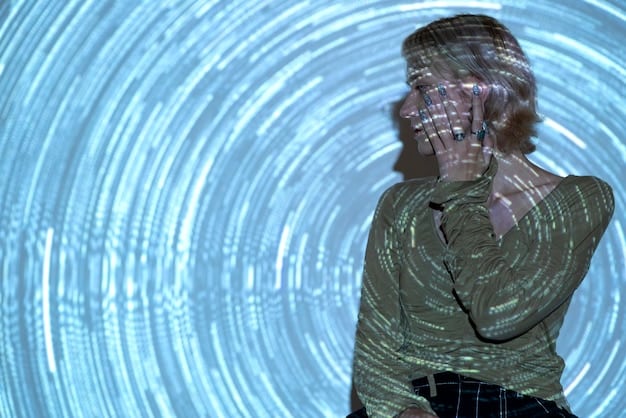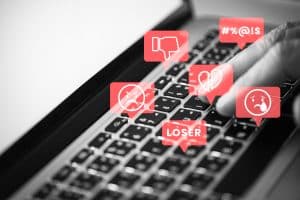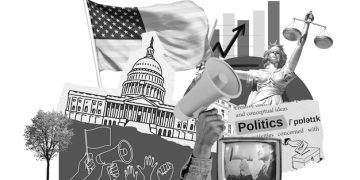Deepfakes and Disinformation: Your Guide to Online Safety in 2025

Anúncios
In 2025, the rise of Deepfakes and Disinformation is reshaping the way we consume content and trust digital information.
With advanced AI making it harder to distinguish real from fake, protecting yourself has never been more important. These synthetic realities are not only deceiving viewers but also fueling misinformation and undermining public trust.
Anúncios
This guide will equip you with the knowledge and tools needed to recognize, resist, and respond to these evolving threats.
Understanding the Deepfake Threat in 2025

In 2025, the threat posed by Deepfakes and Disinformation has grown into a serious and complex digital phenomenon.
Anúncios
What once started as experimental content has evolved into highly realistic and accessible tools used to manipulate perception, influence behavior and spread falsehoods on a massive scale.
Understanding the scope and sophistication of deepfakes today is essential for anyone navigating online spaces.
The Evolution of Deepfake Technology
Deepfake tools are no longer limited to simple video overlays or face replacements.
They now employ advanced artificial intelligence and machine learning to produce convincing, real-time simulations of people’s faces, voices, and movements.
Key advancements include:
- The ability to replicate facial expressions, eye contact, and emotional tone with astonishing precision
- Voice cloning that mimics speech patterns and tone using only small audio samples
- Real-time video synthesis that allows fake content to be generated instantly during live interactions
- Public access to user-friendly platforms that require little to no technical expertise
As these technologies become more accurate and accessible, the potential for abuse also increases.
The Impact on Society and Trust
The proliferation of Deepfakes and Disinformation is eroding public trust in digital media.
People are becoming unsure of what is real and what has been fabricated, which undermines confidence in journalism, leadership, and even personal relationships.
Key areas of impact include:
Political Manipulation
Fake videos of politicians or public figures can be used to spread false statements, incite unrest, or alter the outcome of elections. These manipulated clips can go viral before fact-checkers have time to respond.
Financial Fraud
Cybercriminals are using deepfakes to impersonate executives during video calls or audio messages, tricking employees into approving wire transfers or sharing sensitive data. This form of social engineering is increasingly difficult to detect.
Reputational Damage
Individuals have been targeted with deepfake content designed to humiliate, discredit, or blackmail them. Even if proven false, the impact on someone’s career or personal life can be devastating.
Why Awareness Matters
The first step in combating the effects of Deepfakes and Disinformation is understanding their nature and spread.
Recognizing that these threats exist and learning how to identify them is essential for everyone, from individuals protecting their digital identity to organizations safeguarding public trust.
Remaining informed about the latest detection methods and deepfake trends helps you build digital resilience and reduces the likelihood of falling victim to synthetic deception.
Identifying Deepfakes: Key Indicators
In an age dominated by Deepfakes and Disinformation, learning how to recognize synthetic content is a vital skill.
As these manipulated media become increasingly convincing, spotting the difference between real and fake requires both attention to detail and a critical mindset.
Detecting deepfakes is not always straightforward. However, understanding the most common indicators can help you analyze suspicious content and avoid being misled.
Visual and Auditory Red Flags
Many deepfakes leave subtle traces that give away their artificial nature. While high-quality content may seem flawless at first glance, close inspection often reveals inconsistencies.
Be alert to:
- Facial glitches, such as unnatural blinking or rigid expressions that don’t match the tone of voice
- Lip-sync issues, where the mouth movements are slightly out of sync with the audio
- Uneven lighting or shadows that don’t match the environment
- Distorted audio, robotic tones or background noise that feels artificial or disconnected
These small anomalies, when noticed together, can signal that the content may have been altered using deepfake technology.
Evaluating the Source and Context
Identifying Deepfakes and Disinformation also involves questioning the origin and purpose of the content. The credibility of the source and the surrounding context can reveal whether something is trustworthy or intentionally deceptive.
Ask yourself:
- Is the content being shared by a verified, reputable platform?
- Does the clip contradict known facts or official statements?
- Are there sensational claims that lack evidence or context?
When content appears suddenly, lacks traceable origin, or evokes strong emotional reactions, it may be designed to manipulate rather than inform.
Tools and Technologies to Detect Deepfakes
Modern threats demand modern solutions. Fortunately, several advanced tools are available to help users and professionals detect Deepfakes and Disinformation more accurately.
AI-Powered Detection Systems
Machine learning models are trained to identify manipulation patterns that humans might miss. These systems analyze pixel distortions, motion inconsistencies, and facial mapping errors.
Digital Forensic Software
Specialized forensic tools can examine metadata, file history, and compression artifacts to detect tampering. These are often used in journalism and law enforcement to verify media authenticity.
Reverse Image and Video Search
By running an image or video through a reverse search engine, you can check if similar content exists elsewhere. This helps uncover whether the media has been repurposed or altered from its original context.
Why It Matters
The more widespread Deepfakes and Disinformation become, the more critical it is to stay ahead of them. Developing a skeptical and analytical mindset is your first line of defense.
Whether you are a casual social media user or a decision-maker in a business or government setting, the ability to detect manipulation is essential.
By combining careful observation with the latest detection technologies, you strengthen your ability to recognize threats, protect your information ecosystem, and reduce the spread of harmful falsehoods.
Protecting Your Digital Identity

As Deepfakes and Disinformation become more sophisticated and widespread, your personal information is more vulnerable than ever.
What you share online can be harvested and manipulated to impersonate you, damage your reputation or even commit fraud in your name.
In this environment, protecting your digital identity is not just a matter of privacy. It is a matter of security.
Securing Your Online Accounts
One of the most effective ways to defend against identity-based attacks is by strengthening your account protection.
Key actions include:
- Using strong, unique passwords for each platform
- Activating two-factor authentication (2FA) to add an extra security layer
- Avoiding password reuse and enabling biometric access where possible
By securing your accounts, you make it significantly harder for malicious actors to access your data or impersonate you using AI-generated media.
Being Careful with the Information You Share
Many deepfakes are generated using publicly available content. The more personal material you publish, the easier it becomes to train algorithms that can replicate your face, voice or behavior.
To minimize exposure:
- Avoid posting high-resolution selfies, detailed location check-ins, or voice recordings
- Think twice before sharing birthdates, work details or family information
- Review your privacy settings on social media platforms regularly
Limiting the availability of personal content online makes it harder for Deepfakes and Disinformation creators to target you.
Monitoring and Managing Your Online Presence
Ongoing vigilance is crucial to catch misuse of your identity early. Proactive monitoring helps you respond quickly if someone tries to use your image, video or personal information maliciously.
Best practices include:
- Setting up Google Alerts for your name and key identifiers
- Performing occasional reverse image searches to track unauthorized content
- Using reputation management tools to keep an eye on how your likeness is being used online
These steps can help you detect deepfake threats and respond before they escalate into larger issues.
Why Proactive Identity Protection Matters
In today’s digital world, the lines between real and fake are increasingly blurred. Deepfakes and Disinformation can turn your online presence into a tool for fraud or manipulation without your knowledge.
Taking a proactive, intentional approach to digital identity protection reduces your vulnerability and empowers you to maintain control over how your likeness and personal data are used.
Staying alert, cautious, and informed is your best defense against the misuse of your identity in a world shaped by artificial media.
Combating Disinformation: Strategies for 2025
In the face of rising Deepfakes and Disinformation, combating false narratives online has become one of the most pressing challenges of the digital era.
These manipulative tactics are designed to deceive, influence public perception and disrupt trust in reliable information.
Addressing this issue in 2025 requires more than just caution. It demands a combination of education, critical thinking and digital tools.
Fact-Checking Before Sharing
The first and most powerful habit you can develop is verifying information before passing it on.
What you can do:
- Use trusted fact-checking platforms like Snopes, PolitiFact or AFP Fact Check
- Search for the same news across multiple reputable sources
- Be cautious with content that seems overly emotional, dramatic or too convenient
Disinformation often relies on speed and emotional reaction. Slowing down and verifying facts reduces its power.
Building Media Literacy Skills
Understanding how media is produced and manipulated is key to resisting Deepfakes and Disinformation.
Media literacy involves:
- Recognizing biases and hidden agendas in headlines and framing
- Analyzing the use of visuals, music or wording that may aim to provoke
- Understanding how algorithms and social media platforms can amplify false content
Educating yourself and others about how media works is one of the most sustainable forms of digital defense.
Supporting Reliable Information Sources
The fight against Deepfakes and Disinformation also depends on strengthening legitimate voices. Sharing and endorsing credible journalism helps drown out manipulated content.
Ways to support trusted sources:
- Follow reputable news organizations with a proven track record of accuracy and transparency
- Avoid engaging with clickbait or unknown websites that lack editorial standards
- Subscribe to independent media that values fact-based reporting
By amplifying truth, you naturally weaken the reach of disinformation.
Practical Techniques for Content Evaluation
You can apply specific steps to assess the reliability of any piece of information you come across.
Cross-Reference Information
Always compare the news or claim with at least two other well-known sources. Disinformation often collapses under scrutiny from multiple perspectives.
Check the Author’s Background
Review the author’s qualifications, affiliations and past work. A credible voice adds legitimacy to the message.
Look for Verifiable Evidence
Trust content that includes clear sources, direct quotes, data references or official documentation. Avoid relying on vague claims or anonymous testimonies.
Why This Matters
In a world increasingly dominated by Deepfakes and Disinformation, every user plays a role in either spreading or stopping false content.
Practicing critical thinking and information hygiene helps create a healthier online space for everyone.
Staying informed, questioning what you see, and encouraging others to do the same are simple but powerful steps toward a more resilient digital society.
The Role of Technology in Fighting Deepfakes and Disinformation

While technology is at the core of synthetic media creation, it is also our strongest ally in the battle against Deepfakes and Disinformation.
As these digital threats become more advanced, so do the tools designed to detect and neutralize them.
Understanding how these technologies work is essential for anyone who wants to stay protected in an increasingly manipulated digital landscape.
AI-Powered Detection Systems
Artificial intelligence is one of the most powerful tools in identifying deepfakes. Sophisticated algorithms can scan visual and auditory content to spot signs of digital alteration that the human eye would likely miss.
These systems can:
- Analyze frame-by-frame inconsistencies in videos
- Detect irregularities in facial movements and voice patterns
- Compare real-time data with known authentic samples
By automating the detection process, AI helps uncover even the most realistic instances of Deepfakes and Disinformation.
Blockchain for Media Authentication
Blockchain technology offers a promising solution for verifying the origin and integrity of digital content.
By recording the metadata of a file, such as time, location and device used, in a decentralized ledger, blockchain creates a permanent, tamper-proof trace.
This approach ensures:
- Transparent tracking of when and where content was created
- Easier verification of whether a video or image has been altered
- Reduced opportunity for malicious actors to spread synthetic media unnoticed
When implemented properly, blockchain can restore trust in digital information by proving authenticity at the source.
Collaboration Between Companies, Developers and Researchers
No single entity can solve the challenge of Deepfakes and Disinformation alone. Meaningful progress requires active collaboration across industries and sectors.
This cooperation involves:
- Sharing datasets of deepfake content to train detection algorithms more effectively
- Creating open-source tools that help smaller platforms and journalists detect fake media
- Establishing cross-platform policies to limit the spread of known disinformation
When tech companies, researchers and policymakers work together, the response becomes faster, more accurate and scalable.
Why Tech Innovation Matters in the Fight Against Deepfakes
The threats posed by Deepfakes and Disinformation are dynamic. This means that detection tools must evolve just as quickly.
By investing in innovative solutions and adopting emerging technologies, we gain critical leverage in identifying and stopping manipulated content before it spreads.
Remaining informed about these technological advances empowers individuals and organizations to use available tools effectively and proactively.
Staying Ahead of the Curve: Future Trends in Deepfakes and Disinformation
The battle against Deepfakes and Disinformation is not static. It is an evolving challenge that demands constant attention, adaptability and forward-thinking.
As technology advances, so do the methods used to create and spread synthetic content. Staying informed about future trends is essential to remain resilient in this digital arms race.
By anticipating how Deepfakes and Disinformation will develop, individuals, companies and institutions can take proactive steps to protect their digital environments.
The Evolution of AI and Deepfake Technology
Artificial intelligence is becoming more powerful, faster and more accessible. As a result, the next generation of deepfakes will be even more realistic, interactive and difficult to detect.
Key expectations include:
- Increased use of real-time deepfake generation in live video or voice calls
- Improved AI models capable of replicating personality traits and emotional nuances
- The rise of deepfake-as-a-service platforms, making advanced tools available to non-experts
These advancements will expand the reach and impact of Deepfakes and Disinformation, especially in political, financial and personal spheres.
The Importance of Continuous Learning
The ability to keep pace with new threats depends on a commitment to lifelong digital education. Understanding how deepfakes are created, how disinformation spreads, and how detection tools evolve is no longer optional.
To stay updated:
- Follow trusted cybersecurity blogs, tech news outlets and academic institutions
- Participate in digital literacy workshops or e-learning programs
- Share verified resources and learning materials within your community or workplace
A well-informed public is the strongest defense against the ongoing rise of Deepfakes and Disinformation.
Building a Culture of Skepticism and Critical Thinking
As manipulated content becomes harder to recognize, the role of skepticism becomes more important. Encouraging critical thinking helps prevent the automatic spread of misleading content.
Ways to encourage digital skepticism:
- Teach others to ask “Who created this?”, “Why was it created?” and “Where is the evidence?”
- Promote open discussion about digital manipulation, especially with younger audiences
- Normalize the habit of verifying before sharing
When people learn to pause and question, the viral power of Deepfakes and Disinformation weakens considerably.
Why Preparing for the Future Is Essential
The future of Deepfakes and Disinformation will be defined by speed, realism and psychological influence.
Whether through fake audio clips during live interviews or entirely fabricated public statements, the potential for disruption is real.
By embracing media literacy, advancing detection tools and building informed communities, we strengthen our collective resilience. Vigilance, education and collaboration will be the pillars of a trustworthy digital environment.
Staying ahead is not just a technological necessity. It is a social responsibility that impacts democracy, safety and truth itself.
| Key Point | Brief Description |
|---|---|
| 🤔 Identifying Deepfakes | Look for visual and auditory inconsistencies; check the source. |
| 🛡️ Protecting Identity | Secure accounts, limit personal sharing, monitor online presence. |
| 📰 Combating Disinformation | Fact-check, improve media literacy, support trusted sources. |
| 🤖 Tech’s Role | AI, blockchain, and collaboration are crucial for detection. |
Frequently Asked Questions
▼
In 2025, deepfakes can manipulate elections, facilitate sophisticated fraud, damage reputations, and erode trust in institutions, making it crucial to stay vigilant and informed.
▼
Look for inconsistencies in lighting, unnatural movements, or artifacts in the video. Also, cross-reference the video with trusted news sources to verify its authenticity.
▼
Use strong, unique passwords, enable two-factor authentication, be mindful of what you share online, and regularly monitor your online presence for any unauthorized use of your data.
▼
Media literacy is the ability to critically evaluate information sources and recognize bias. It’s essential for distinguishing credible information from disinformation and manipulated content.
▼
AI-powered detection tools, blockchain verification, and collaborative efforts between tech companies and researchers are vital in identifying and preventing the proliferation of deepfakes and disinformation.
Final Thoughts
In 2025, understanding and combating Deepfakes and Disinformation is no longer a specialized task for cybersecurity experts.
It is a daily necessity for anyone who uses the internet, consumes news, or engages on social media.
These technologies are evolving rapidly and becoming more accessible, making it easier than ever for malicious actors to distort reality and manipulate audiences.
The impact of Deepfakes and Disinformation extends far beyond individual users. They threaten democratic processes, enable large-scale fraud, and damage trust in institutions, media, and even personal relationships.
As highlighted in the Forbes report, this phenomenon has become a billion-dollar risk for companies and governments alike.
Meanwhile, The Conversation explains how AI-generated misinformation played a complex but significant role in the 2024 elections, shaping opinions and sowing confusion.
To stay protected, individuals must adopt a mindset of critical thinking and digital responsibility.
Recognizing visual and auditory cues, verifying sources, and using AI-powered detection tools are important steps, but equally vital is fostering a culture where truth and transparency are valued.
Sharing verified information, questioning suspicious content, and supporting ethical journalism all contribute to a safer digital environment.
Deepfakes and Disinformation are not going away. They are becoming more advanced, more deceptive, and more embedded in our digital lives.
But with education, vigilance, and the right tools, we can minimize their impact and empower ourselves and our communities.
The path forward depends on awareness and action. By staying informed, questioning content critically, and defending your digital identity, you are not just protecting yourself.
You are helping build a more resilient, informed, and trustworthy online world.
Liked the article?





